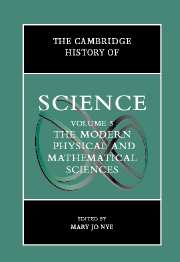Book contents
- Frontmatter
- Introduction: The Modern Physical and Mathematical Sciences
- Part I The Public Cultures of the Physical Sciences After 1800
- Part II Discipline Building in the Sciences: Places, Instruments, Communication
- Part III Chemistry and Physics: Problems Through the Early 1900s
- Part IV Atomic and Molecular Sciences in the Twentieth Century
- Part V Mathematics, Astronomy, and Cosmology Since the Eighteenth Century
- Part VI Problems and Promises at the End of the Twentieth Century
- 29 Science, Technology, and War
- 30 Science, Ideology, and the State
- 31 Computer Science and the Computer Revolution
- 32 The Physical Sciences and the Physician’s Eye: Dissolving Disciplinary Boundaries
- 33 Global Environmental Change and the History of Science
- Index
- References
31 - Computer Science and the Computer Revolution
from Part VI - Problems and Promises at the End of the Twentieth Century
Published online by Cambridge University Press: 28 March 2008
- Frontmatter
- Introduction: The Modern Physical and Mathematical Sciences
- Part I The Public Cultures of the Physical Sciences After 1800
- Part II Discipline Building in the Sciences: Places, Instruments, Communication
- Part III Chemistry and Physics: Problems Through the Early 1900s
- Part IV Atomic and Molecular Sciences in the Twentieth Century
- Part V Mathematics, Astronomy, and Cosmology Since the Eighteenth Century
- Part VI Problems and Promises at the End of the Twentieth Century
- 29 Science, Technology, and War
- 30 Science, Ideology, and the State
- 31 Computer Science and the Computer Revolution
- 32 The Physical Sciences and the Physician’s Eye: Dissolving Disciplinary Boundaries
- 33 Global Environmental Change and the History of Science
- Index
- References
Summary
Until the mid-1950s, the word “computer” commonly referred to a woman employed in operating a calculating machine in a business office or a scientific calculating laboratory. With the invention in 1945 of the stored-program computer, several months after the Second World War ended, and with the publicity surrounding the introduction in 1952 of the first commercial computer (the Universal Automatic Computer, or UNIVAC), the word computer became associated with a machine, rather than a human.
This machine had three attributes that rendered prior calculating technologies obsolete in less than two decades. The electronic switching of its components eventually made the computer billions of times faster than its mechanical ancestors. The digital storage of information enhanced precision to practically unrestricted levels. The stored program capability, that is, the ability to store instructions as well as data inside the machine and to have the machine process those instructions during the course of a computation without human intervention, had two advantages: First, it enabled almost any computer to be used as a universal machine, in other words, to carry out virtually any computation possible by a machine. Second, stored programming was critical to the automation of the computational process, so that the overall speed of computation could reflect the electronic speed of the components.
Information
- Type
- Chapter
- Information
- The Cambridge History of Science , pp. 598 - 614Publisher: Cambridge University PressPrint publication year: 2002
